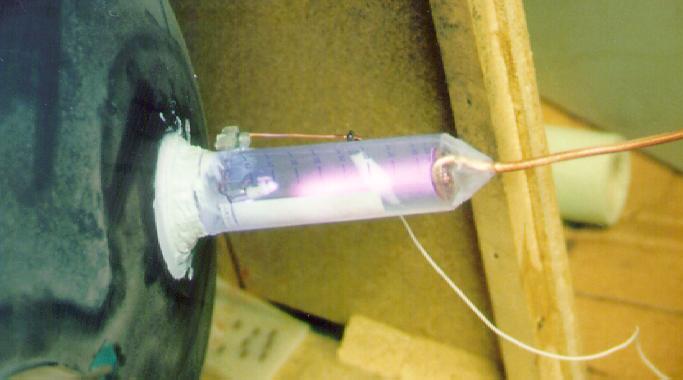
One of the most fascinating things is the strange light of a low-pressure gas discharge. Unfortunatly, you normally need a vacuum pump for this :-(. But, I finally found a simple way of using a CRT as a pump, and evacuate a plastic tube to a low enough pressure (about 10 mbar):

To try this yourself, you need a CRT from a TV set, a suitable plastic tube (3cm diameter, 10cm long, strong enough so that you can't distort it much between your fingers), suitable pieces of metal for the electrodes, a plastic inflatable ball or soft plastic foil 1-2mm thick, epoxy glue and silicone sealing compound.
Drill small holes at the top and base of the tube and glue the electrodes in with a lot of epoxy glue. Leave this to harden for 12 hours. Your tube must then be airtight except for the base opening.
Find the small metal plate in the side wall of the CRT where the HV cable is pugged in. Only this thin plate separates the near absolute vacuum in the CRT from the surrounding air pressure here. Clean the surrounding area thoroughly with alcohole. Cut two rings from the plastic ball that leave the plug free (5mm diameter), but cover a sufficient area around it (4cm diameter). Smear some silicon on them and press them (one on top of the other) onto the CRT wall. They must adhere smoothly. Put some more silicon on top, so that the tube rim can later be pressed into it. Leave this to dry for about 2 hours (the silicon needs 12-24 hours to dry completely).
Take a small, sharp gimlet or other suitable tool and work cautiously through the metal plate. This might take some minutes. As soon as you hear the air rushing in, quickly press the tube onto the sealing rings and hold it in place for a few minutes. After that, the outer air pressure should hold it. If you want to make really sure, seal the join of CRT and tube with more silicon now.
That's it ! To test the tube, you need about 10kV voltage (or more). If all went right, you should then see a similar light effect as on the photo above. Here's another photo to illustrate the arrangement:

The exact shape of the gas discharge depends heavily on how good the vacuum is. This, in turn, gets better
In any case, the vacuum should be good enough to get a gas discharge going, but too bad to produce cathode rays or x-rays. The maximum you'll reach with sensible dimensions is about 1mbar.